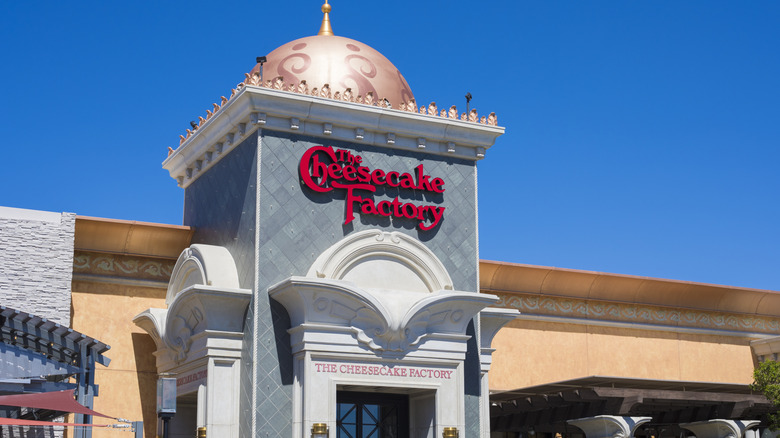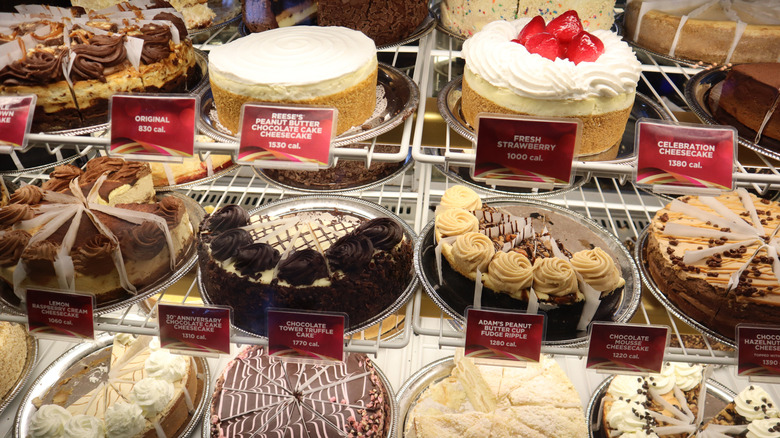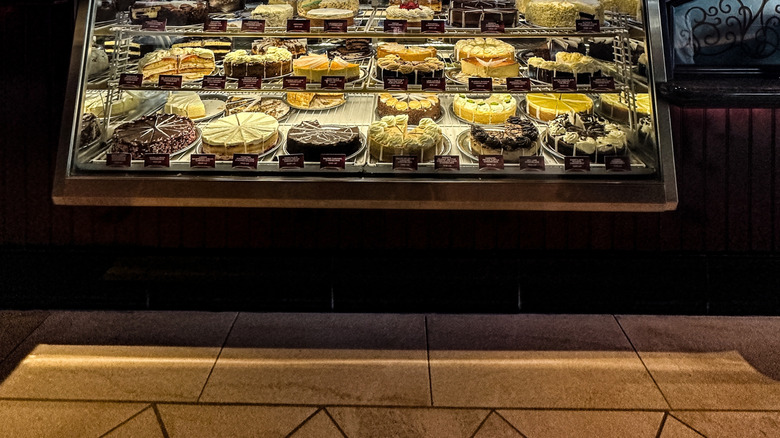It's Time For Cheesecake Factory To Dump The SkinnyLicious Menu
If you've spent any time near America's strip malls, you've probably walked by the somewhat ostentatious, stadium-sized Cheesecake Factory. Its notoriously hefty menu with more than 250 food items and inexplicable mishmash of interior design styles has made the chain an ironic time capsule for nostalgic millennials. But lurking within that novella-sized menu is the "SkinnyLicious" offerings.
Launched in 2011, the Skinnylicious stand-alone menu consists of around 50 food options, ranging from appetizers and small plates to entree salads and main course meals. The chief executive and son of the founders, David Overton, claimed the goal there was to "deliver an exceptional dining experience to ... calorie-conscious guests, without compromising the delicious taste that people had come to expect."
Now more than a decade old, the so-called skinny menu isn't aging so well. Its officially described as a "collection of fresh and delicious menu options with lower calories and signature rich taste." For a restaurant that prides itself on decadent cheesecakes and rich foods, there's a real cognitive dissonance here of wedging a "skinny" menu within the main one. Some of these menu items existed previously, like the chicken pot stickers, while others were new, such as the Mexican tortilla salad. But all dishes were now marketed as 590 calories or less, with even cocktails getting the skinny treatment at just 150 calories.
Even on menus, words matter
Just the term "skinnylicious" is a loaded one. Though we still have far to go, society has come a long way with how we perceive good health and body types. Words like "good fat," "chubby," "waif-thin," or, yes, skinny are all terms that connote judgment and body shaming. Bringing this type of toxic attitude into a fast-casual chain restaurant renowned for its hearty portions and "dessert first" mentality is not only bad business, it's harmful to people who struggle with body acceptance.
Nutritionists have long argued that lumping foods into good and bad categories is damaging and leads to an unhealthy relationship with eating. Simply put, The Cheesecake Factory (and much of diet culture in America) is continuing to assign a moral value to salads and sweets. This skewed sense of morality is why it's still fashionable or accepted to view people who stick to a "skinny menu" as morally superior. And from this, others feel full of shame after eating a slice of cheesecake from the restaurant that adopted the name.
Why skinny doesn't mean healthy
Even without the problematic and inherently judgmental title, are foods on this so-called Skinnylicious menu actually healthy? Just because a food has low calories doesn't mean it's going to be nutritionally well-rounded or actually fill you up. Remember that TCF only promises lower calories, but mentions nothing about saturated fat, sugar, or sodium. Blanket labeling certain foods as "skinny" is false advertising and bad marketing all wrapped up in one salt-laden SkinnyLicious® Shrimp Soft Taco. Going out to dinner should be a time of bonding over a shared meal, not having a publicly traded corporation pass moral judgments on what you order. Seeing a refrigerated wall of enticing cheesecakes when one walks into the vaguely Vegas-Egyptian interior, only to be confronted by a supercilious menu that promises you a "skinny" ending, is peak nutritional whiplash.
It's worth noting these skinny offerings came out in 2011, right on the heels of the menu labeling mandate that was part of the Affordable Care Act (ACA) of 2010. It's probably no coincidence that The Cheesecake Factory felt compelled to offer "lighter" options after the FDA issued regulations requiring chain restaurants to post calorie counts for menu items, self-service food, and food on display. But remember that our health does not entirely depend on what we eat. And eating healthily doesn't mean one eats only dry salads and flaxseed smoothies.TCF isn't solely responsible for America's toxic diet culture, but it certainly can stop contributing to the moral hierarchy of "good" and "bad" foods.


